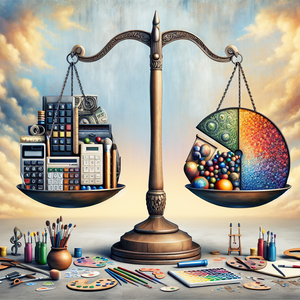The Role of Creativity in Government Digital Services

Creativity is often seen as a trait reserved for artists and designers, but in the context of GDIT, it is an essential skill that drives innovation and effectiveness. Government agencies face unique challenges, from improving citizen engagement to streamlining operations and enhancing service delivery. Creative thinking allows teams to approach these challenges from new angles, leading to more effective and user-friendly solutions. For instance, the United States Digital Service (USDS) has made significant strides in improving government services through creativity. One of their notable projects involved redesigning the Veterans Affairs (VA) website. By employing a user-centric design approach, the team not only improved the aesthetic appeal of the site but also significantly enhanced its functionality, ultimately leading to better service for veterans. This project exemplifies how creative thinking can lead to tangible improvements in government services.
Supporting Evidence: Successful Creative Initiatives
Several other examples underscore the impact of creativity in GDIT. The City of San Francisco launched an initiative called “SF Open 311,” which creatively engages citizens by allowing residents to report non-emergency issues via a mobile app. This approach not only fosters community involvement but also streamlines the city’s response to public concerns. By leveraging technology creatively, San Francisco has improved its responsiveness and accountability to its citizens. Moreover, the integration of artificial intelligence (AI) into government services showcases how creativity can enhance operational efficiency. The U.S. Citizenship and Immigration Services (USCIS) implemented AI-driven chatbots to assist applicants with their queries. This innovative use of technology has not only reduced wait times but also improved the overall user experience, demonstrating how creative solutions can address persistent challenges in public service. Additionally, the U.K. Government Digital Service (GDS) has revolutionized how government interacts with citizens through the creation of a unified digital platform. Their approach focuses on user needs and seamless digital interaction, which has resulted in improved service delivery across various departments. This initiative highlights the effectiveness of applying creative methodologies to public services, leading to enhanced accessibility and efficiency.
Fostering a Creative Environment in GDIT
To harness the power of creativity in GDIT, agencies must cultivate environments that encourage innovative thinking. This can be achieved through fostering a culture of collaboration, allowing employees to experiment without fear of failure, and providing opportunities for professional development in creative problem-solving techniques. For instance, hackathons and innovation labs have become popular in various government agencies, where interdisciplinary teams come together to brainstorm and develop solutions to specific issues. These initiatives not only inspire creativity but also promote team cohesion and a shared sense of purpose among employees. The U.S. Department of Health and Human Services, for example, has organized hackathons to tackle public health challenges, resulting in innovative solutions that directly benefit the community. Moreover, integrating design thinking principles into government processes can further enhance creativity. By focusing on empathy for users, agencies can identify pain points in service delivery and devise solutions that cater to the actual needs of citizens. This approach has been successfully implemented in various federal and local government projects, resulting in improved outcomes and increased citizen satisfaction.
As government digital services continue to evolve, the importance of creativity cannot be overstated. It is the key to solving complex problems, improving service delivery, and enhancing citizen engagement. By embracing innovative thinking and fostering a creative culture, government agencies can not only adapt to the challenges of the digital age but also lead the way in transforming public service for the better. Ultimately, creativity is not just an asset; it is a necessity for those looking to thrive in the ever-changing landscape of government digital services. As we move forward, inspiring a culture of creativity within GDIT will be crucial in shaping responsive and effective public services that truly meet the needs of the citizens they serve.
User Experience (UX) Designer for Government Services
U.S. Digital Service, U.K. Government Digital Service, local government agencies
Core Responsibilities
Conduct user research to understand the needs and behaviors of citizens interacting with government services.
Design user-friendly interfaces for websites and applications that enhance accessibility and engagement.
Collaborate with cross-functional teams, including developers and product managers, to implement design solutions.
Required Skills
Proficiency in design tools such as Sketch, Figma, or Adobe XD.
Strong understanding of user-centered design principles and usability testing.
Experience with responsive design and accessibility standards (WCAG).
Digital Product Manager for Public Sector Initiatives
Various government agencies, tech firms specializing in public sector solutions
Core Responsibilities
Oversee the development and lifecycle of digital products aimed at improving government services.
Define product vision and strategy based on user needs, market trends, and technological advancements.
Coordinate with stakeholders and development teams to ensure timely delivery of product features.
Required Skills
Excellent project management skills, with experience in Agile or Scrum methodologies.
Strong analytical skills to assess product performance and user feedback.
Ability to communicate complex concepts to both technical and non-technical audiences.
Data Analyst for Government Digital Transformation
Government analytics departments, consulting firms specializing in public sector data solutions
Core Responsibilities
Analyze large datasets to identify trends and insights that inform policy and service improvements.
Create dashboards and visualizations to communicate data findings to stakeholders.
Collaborate with IT teams to ensure data integrity and security in government systems.
Required Skills
Proficiency in data analysis tools such as SQL, R, or Python, and visualization tools like Tableau or Power BI.
Strong problem-solving skills and attention to detail.
Experience working with government datasets and understanding regulatory compliance.
Innovation Specialist in Government Agencies
Local and federal government innovation labs, nonprofit organizations focused on civic tech
Core Responsibilities
Facilitate workshops and hackathons to generate creative solutions for public service challenges.
Research and implement best practices in innovation from both the private and public sectors.
Develop and maintain partnerships with tech startups and other organizations to drive collaboration.
Required Skills
Strong facilitation and communication skills to engage diverse stakeholders.
Knowledge of design thinking methodologies and innovation frameworks.
Experience with project management and strategic planning.
Artificial Intelligence (AI) Solutions Architect for Public Services
Government agencies, tech firms specializing in AI solutions for public services
Core Responsibilities
Design and implement AI-driven solutions to improve the efficiency of government services.
Collaborate with data scientists and software developers to integrate AI technologies into existing systems.
Assess the impact of AI initiatives on service delivery and citizen engagement.
Required Skills
Solid understanding of machine learning algorithms and AI frameworks (e.g., TensorFlow, PyTorch).
Experience with cloud platforms (AWS, Azure, Google Cloud) and data engineering.
Strong communication skills to explain technical concepts to non-technical stakeholders.


